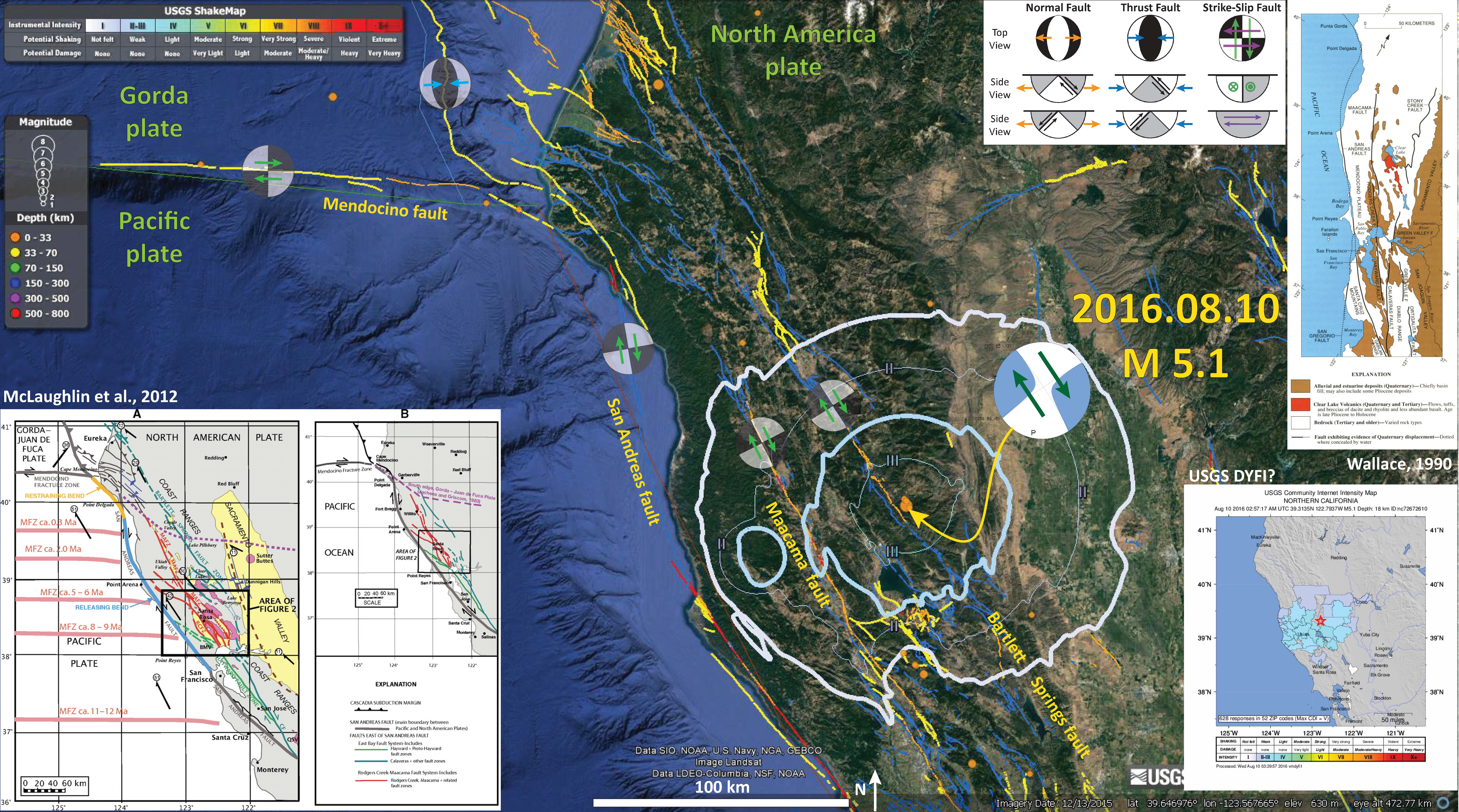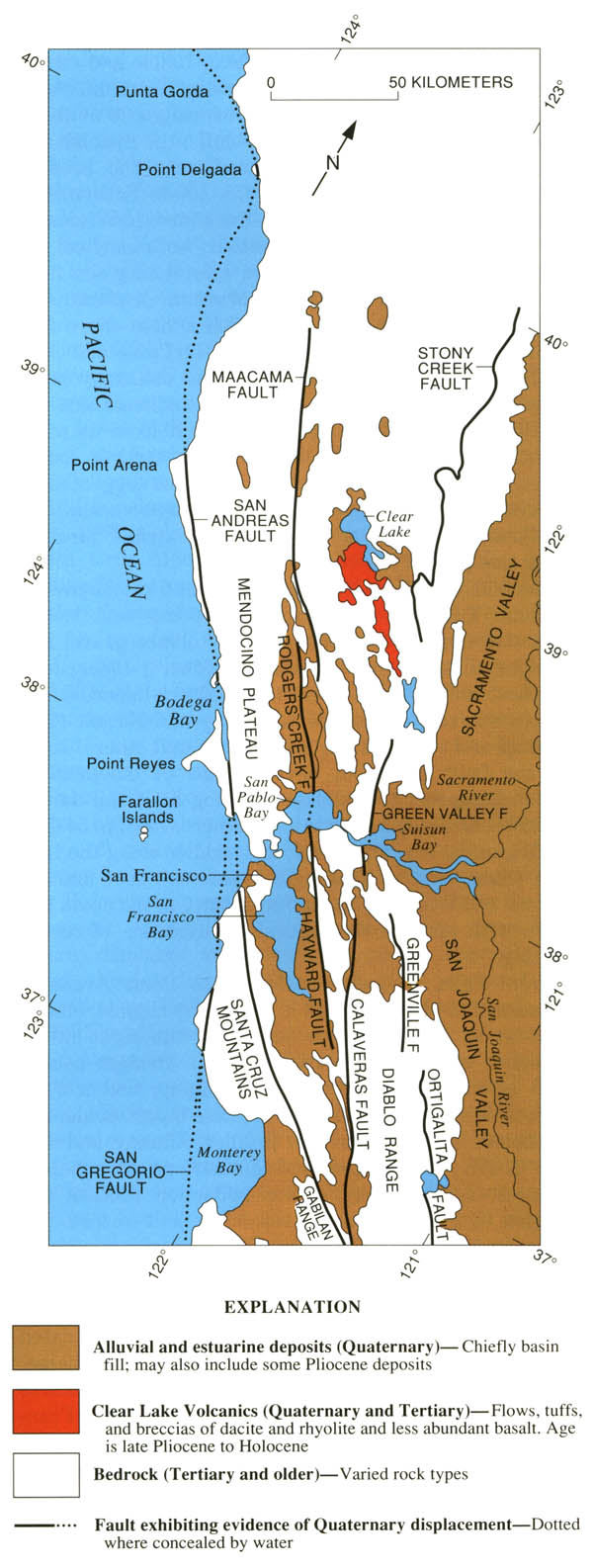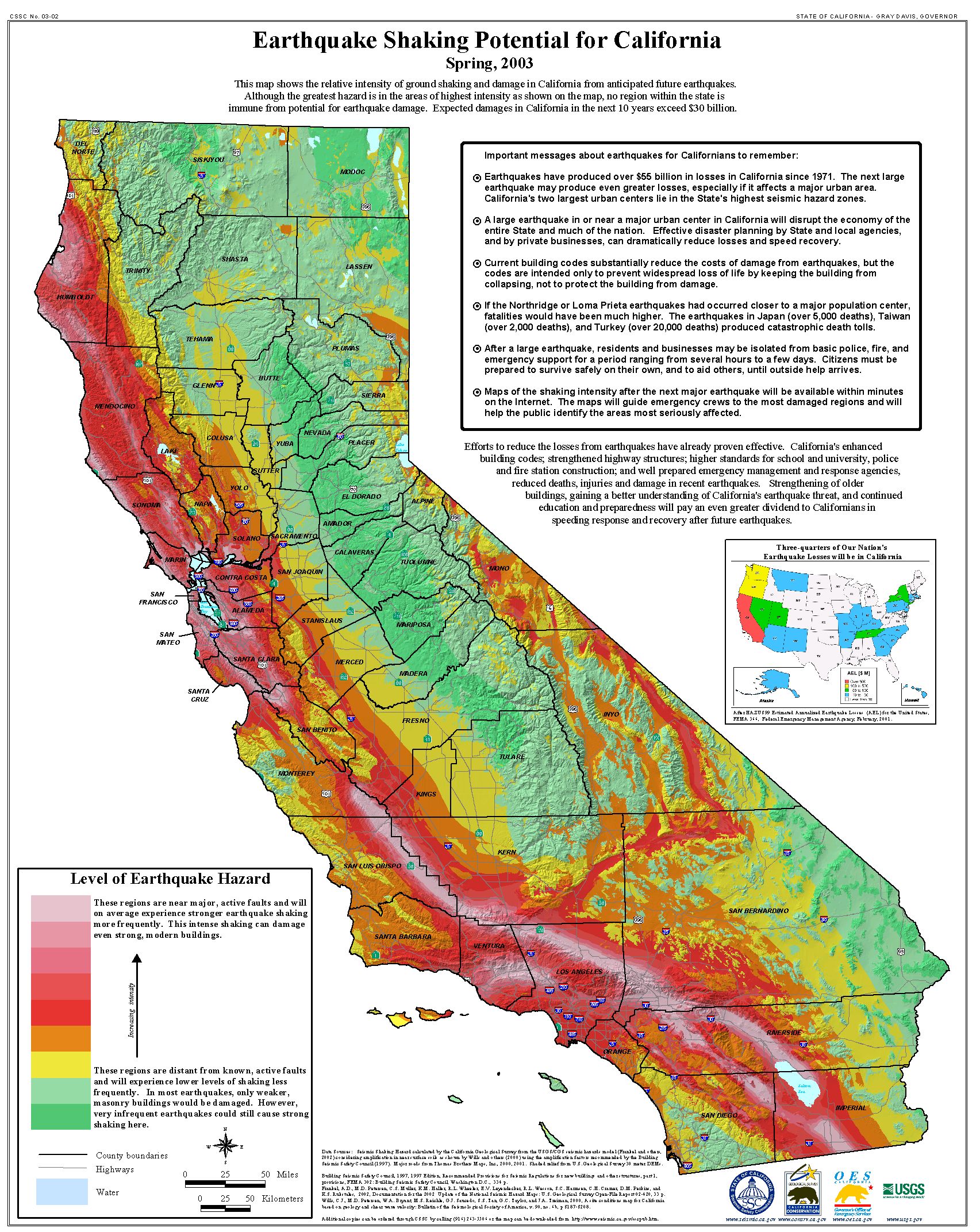We just had a good sized earthquake adjacent to the mapped surface trace of the Bartlett Springs fault, southeast of Lake Pillsbury. Here is the USGS website for the M 5.1 earthquake.
Here is my interpretive map that shows the epicenter, along with the shaking intensity contours. These contours use the Modified Mercalli Intensity (MMI) scale. The MMI is a qualitative measure of shaking intensity. More on the MMI scale can be found here and here. This is based upon a computer model estimate of ground motions, different from the “Did You Feel It?” estimate of ground motions that is actually based on real observations. See the attenuation plot versus distance below to compare the difference between this model estimate and the real observations. The fit is pretty good.
I plot the moment tensor for this earthquake and I interpret this earthquake to be a northwest striking right lateral strike-slip earthquake. This is based upon the mapped faults in the region and their sense of motion, which is synthetic to the San Andreas fault system to the west. I used this kml to make this map.
The San Andreas fault is a right-lateral strike-slip transform plate boundary between the Pacific and North America plates. The plate boundary is composed of faults that are parallel to sub-parallel to the SAF and extend from the west coast of CA to the Wasatch fault (WF) system in central Utah (the WF runs through Salt Lake City and is expressed by the mountain range on the east side of the basin that Salt Lake City is built within). There was a recent earthquake between the San Andreas and Maacama faults in August of 2016. The three main faults in the region north of San Francisco are the SAF, the MF, and the Bartlett Springs fault (BSF). The SAF, MF, and BSF are all right lateral strike-slip fault systems. Without more seismicity or mapped faults to suggest otherwise, this is a reasonable interpretation.
-
I include some insets in the map below:
- In the upper right corner, I place a map shows the configuration of faults in central (San Francisco) and northern (Point Delgada – Punta Gorda) CA (Wallace, 1990).
- To the left of that, There is a legend that shows how moment tensors can be interpreted. Moment tensors are graphical solutions of seismic data that show two possible fault plane solutions. One must use local tectonics, along with other data, to be able to interpret which of the two possible solutions is correct. The legend shows how these two solutions are oriented for each example (Normal/Extensional, Thrust/Compressional, and Strike-Slip/Shear). There is more about moment tensors and focal mechanisms at the USGS.
- In the lower right corner I include one version of the Did You Feel It? map. This is the result of people submitting their observations on the USGS website.
- In the lower left corner, I include a map that shows the major fault systems in this region (McLaughlin et al., 2012). In their 2012 publication, McLaughlin et al. present their interpretations for the evolution of the Rogers Creek-Maacama right-lateral fault system, the SAF plate boundary fault system to the west of the Bartlett Springs fault system.

This map shows today’s seismicity as red and orange circles. Faults are mapped as red lines and compare with the map above to note that from left to right (west to east) are the SAF, MF, and BSF. Fort Bragg is located in the northwest part of the map and Sacramento is in the southeast part of the map.
This plot shows how the ground motions decay with distance from the earthquake. The blue dots show the survey results and the orange line shows how a computer simulation based attenuation model suggests that the ground motions would reduce with distance from the earthquake. The orange dots show the median data for each data bin. Note how well the observations fit the attenuation (i.e. Ground Motion Prediction Equation) models.
.jpg)
This is my interpretive map for the earthquake from August 8, 2015. Compare the MMI contours with the interpretive map for today’s M 5.1 earthquake. These maps are at a similar scale.

I created an animation that shows the seismicity of this region from 1960 through Sunday, 2015.08.30. While this animation was made for a different earthquake (from 2015), it still reveals where the historic seismicity is located. Note how there is little recent historic seismicity in the region of today’s M 5.1earthquake. This is the USGS query that I used to create the animation, in the form of a kml file. Here is a static map that shows all earthquakes for this region.
Here is the animation. Either download the file here or click on the animation below.
Here is the (Wallace, 1990) map. I include the figure caption as a blockquote below. Below the citation is this map presented on its own.

Geologic sketch map of the northern Coast Ranges, central California, showing faults with Quaternary activity and basin deposits in northern section of the San Andreas fault system. Fault patterns are generalized, and only major faults are shown. Several Quaternary basins are fault bounded and aligned parallel to strike-slip faults, a relation most apparent along the Hayward-Rodgers Creek-Maacama fault trend.
Here is a map that shows some slip rates for the faults that make up the Pacific-North America plate boundary system (Wallace, 1990). I include the figure caption as a blockquote below. Below the citation is this map presented on its own.


Sketch map of western and southwestern California, showing selected major faults exhibiting evidence of Quaternary activity in the San Andreas fault system. Average Quaternary slip rates are based on measured values from published sources and, where measurements are incomplete or unavailable, on interpreted geologic and geomorphic evidence. Slip components on northwest-trending faults are predominantly horizontal, right lateral, and consistent with North American-Pacific plate motion Group of east-west-trending faults between lat 34°00′ and 35°30′ N. exhibit a more complex slip pattern, including chiefly reverse faulting but also some strike slip. Areas above 600-m elevation (colored) exhibit evidence of late Cenozoic uplift and enclose most areas of Quaternary uplift, but elevation pattern reveals no such major local uplifts as those near Ventura (approx 1 cm/yr) and along the Newport-Inglewood fault zone (NI). Faults dotted where concealed by water.
About 75% of the relative plate motion is accommodated along the SAF and its synthetic sister faults in the northern CA region. The rest of the plate boundary motion is accommodated along the Eastern CA shear zone and Walker Lane, along with the Central Nevada Seismic Belt, and the Wasatch fault systems. In Northern CA, there is about 33-37 mm/yr strain accumulated on the SAF plate boundary system. About 18-25 mm/yr is on the SAF, 8-11 mm/yr on the MF, and 5-7 mm/yr on the Bartlett Springs fault system (Geist and Andrews, 2000).
-
Here is a map from McLaughlin et al. (2012) that shows the regional faulting. I include the figure caption as a blockquote below.
- Geist, E.L. and Andrews D.J., 2000. Slip rates on San Francisco Bay area faults from anelastic deformation of the continental lithosphere, Journal of Geophysical Research, v. 105, no. B11, p. 25,543-25,552.
- McLaughlin, R.J., Sarna-Wojcicki, A.M., Wagner, D.L., Fleck, R.J., Langenheim, V.E., Jachens, R.C., Clahan, K., and Allen, J.R., 2012. Evolution of the Rodgers Creek–Maacama right-lateral fault system and associated basins east of the northward-migrating Mendocino Triple Junction, northern California in Geosphere, v. 8, no. 2., p. 342-373.
- Wallace, Robert E., ed., 1990, The San Andreas fault system, California: U.S. Geological Survey Professional Paper 1515, 283 p. [http://pubs.usgs.gov/pp/1988/1434/].

Maps showing the regional setting of the Rodgers Creek–Maacama fault system and the San Andreas fault in northern California. (A) The Maacama (MAFZ) and Rodgers Creek (RCFZ) fault zones and related faults (dark red) are compared to the San Andreas fault, former and present positions of the Mendocino Fracture Zone (MFZ; light red, offshore), and other structural features of northern California. Other faults east of the San Andreas fault that are part of the wide transform margin are collectively referred to as the East Bay fault system and include the Hayward and proto-Hayward fault zones (green) and the Calaveras (CF), Bartlett Springs, and several other faults (teal). Fold axes (dark blue) delineate features associated with compression along the northern and eastern sides of the Coast Ranges. Dashed brown line marks inferred location of the buried tip of an east-directed tectonic wedge system along the boundary between the Coast Ranges and Great Valley (Wentworth et al., 1984; Wentworth and Zoback, 1990). Dotted purple line shows the underthrust south edge of the Gorda–Juan de Fuca plate, based on gravity and aeromagnetic data (Jachens and Griscom, 1983). Late Cenozoic volcanic rocks are shown in pink; structural basins associated with strike-slip faulting and Sacramento Valley are shown in yellow. Motions of major fault blocks and plates relative to fi xed North America, from global positioning system and paleomagnetic studies (Argus and Gordon, 2001; Wells and Simpson, 2001; U.S. Geological Survey, 2010), shown with thick black arrows; circled numbers denote rate (in mm/yr). Restraining bend segment of the northern San Andreas fault is shown in orange; releasing bend segment is in light blue. Additional abbreviations: BMV—Burdell Mountain Volcanics; QSV—Quien Sabe Volcanics. (B) Simplifi ed map of color-coded faults in A, delineating the principal fault systems and zones referred to in this paper.
Here is a map that shows the shaking potential for earthquakes in CA. This comes from the state of California here. I include the figure caption as a blockquote below.

Earthquake shaking hazards are calculated by projecting earthquake rates based on earthquake history and fault slip rates, the same data used for calculating earthquake probabilities. New fault parameters have been developed for these calculations and are included in the report of the Working Group on California Earthquake Probabilities. Calculations of earthquake shaking hazard for California are part of a cooperative project between USGS and CGS, and are part of the National Seismic Hazard Maps. CGS Map Sheet 48 (revised 2008) shows potential seismic shaking based on National Seismic Hazard Map calculations plus amplification of seismic shaking due to the near surface soils.
-
References

2 thoughts on “Earthquake Report: Bartlett Springs fault system, Lake Pillsbury”